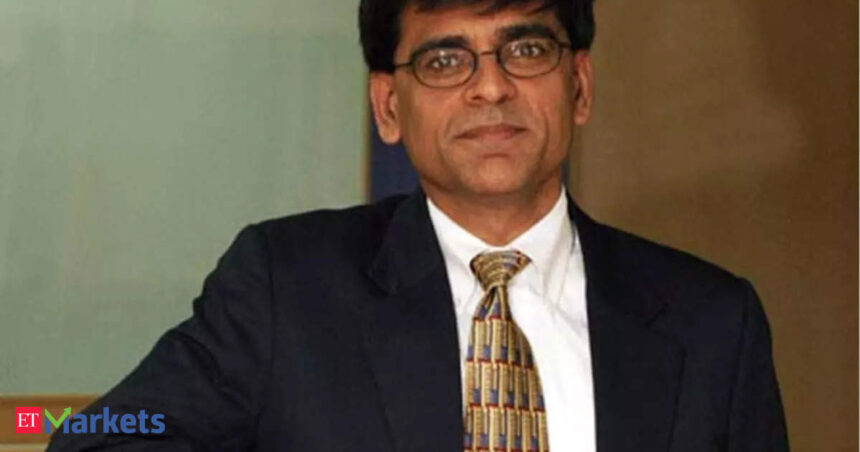Today is an interesting day because the Nifty after going to almost 19,200 or thereabout has come back to 19,600-19,700. There was a fear in the market that this change in global narrative of higher for longer which our Governor Das also alluded to today, is likely to dislocate markets globally. Since India has relatively outperformed the world, it was thought that we are likely to fall a lot. But that narrative has not played out entirely in India. How scary is this higher for longer in your view for risky assets overall?
If you look at the way the global interest rates have been, since 1980, you have had basically a one-way bet on interest rates that they will be declining and that is what has happened. In fact, in the last two decades or so, in the last 15 years or so, post Lehman, we have had a whole generation of investors who are basically what we call play money. So, there is money and the minute there is cost to money, it becomes capital.
Unlock Leadership Excellence with a Range of CXO Courses
| Offering College | Course | Website |
|---|---|---|
| Indian School of Business | ISB Chief Technology Officer | Visit |
| Indian School of Business | ISB Chief Digital Officer | Visit |
When interest rates are zero, you have play money and you have created a whole generation of allocators and investors around the world, who are used to making decisions about where to invest on a zero interest rate or low interest rate environment. They have never in their life managed money or capital in a higher interest rate environment. So, what you are seeing really is this dramatic change which I hope as an investor of long term capital will keep everyone more disciplined and the hype will come away from many markets, the overhype that we saw, the VC firms, the unicorns just based upon concepts, not even proper business models, all will disappear. So, India will be impacted because now people will start allocating capital around the world rather than investing play money.
So, they will be more disciplined…
A lot more disciplined. There will be a requirement for a calibrated risk assessment and calibrated returns for the risk you take as opposed to gambling.
So, you are looking at it in a much more positive way.
Yes.
But I would like to go into that part of the argument which Ray Dalios and even Gundlachs of the world are talking about very actively in multiple forums last few weeks. I would say that because of elevated yields last seen 16 years back, we could be in for a pretty nasty kind of a dislocation. How much probability is there for a nasty dislocation and its impact on India?
If you are a pension fund or a sovereign fund investing globally, if you can buy the US 10-year bond at 5% or 4.75% now and eventually maybe 5.25%, you will invest a lot of your capital in that US bond or the euro bond or whichever bond which gives you higher rates of interest. So, you will put less money into riskier asset classes like equity and certainly you will be more careful when you invest in emerging markets because their currencies, their economies may be destabilised by higher interest rates and by virtue and by extension a stronger US dollar.
So, yes, there will be a dislocation to many economies and to many emerging markets, but I think India stands out. We have built this fantastic graph which you can see on the Quantum AMC website or QSL website, where over 40 years, across 10 governments, we are showing how India’s GDP has grown in a fabulous manner and the Indian stock markets have given a 17-18% compounded returns.We are very optimistic on that and believe that India will continue to give potentially a 15% per annum rate of return in rupee terms, even if you knock off 2-3% on a US dollar-Indian rupee basis, as a foreign investor, you still can make 10-11% in dollar terms in India. Since 2000 till now, the Indian stock market in dollar terms has returned four times that of the emerging market indices. We really are a standout economy. We do not need an India shining story. We have been shining for the last 43 years.
Thanks to the demographics, right?
Thanks to the changes in government policies since the early 1980s.
So, it is a continuation which is actually likely to happen.
Absolutely.
Maybe the juggernaut is only gathering speed because they say that after $2,500 per capita, the curve actually steepens quite sharply and development gathers pace. But you are visiting your asset allocator friends across the world these days, you are marketing India pretty aggressively . The three or four major arguments which you are making are why do you have such high visibility on the growth runway six to eight years from here?
Again, looking back in history, we have got this long-term growth story, 6.2% per annum has been India’s average rate of real GDP growth rate from 1980 till 2023. We believe that will remain at 6.2%, 6.5% for the next decade or so. That is the underlying story that you have got an economy and that growing economy gives companies a chance to grow and make more profits.
If you look at stock market returns and GDP, unlike China, India has a one-to-one correlation. When GDP grows, stock market returns grow. In China, that correlation broke about eight-nine years ago and it is not likely to go back given the kind of government and… strong leadership and strong governments who think too much of themselves are dangers to stock market returns for sure. They may not be dangers to GDP growth rate because strong governments or strong leaders can encourage crony capitalism.
We have seen that in Russia, China and there is a complete breakdown between stock market returns and GDP in those countries. Therefore, we pray for coalition governments in some sense because then you have…
It is automatic risk management.
Yes, absolutely, in some sense. But anyway, the India story looks very good for that reason. Of course, it is demographic, it is consumption, but it is also infrastructure, it is also exports. There are a bunch of stories in India for the last few decades and those stories have not changed. The way you cover them may change, but the stories have not changed.
There is a part of the Indian market which is kind of having a party of its own. March onwards and over the last two-three years as well and that is smallcap and midcap spaces. Not only the HNIs and retail but even global investors, FIIs have started taking bets in midcaps and smallcaps. Are Indian smallcaps and midcaps emerging as an asset class in its own way or is it gathering extra froth and attention than it deserves?
We started by talking about play money and if you look at the history of foreign investments into India, it really was into illiquid assets initially, venture capital, private equity and real estate. They got more money in some sense than the larger caps did and that is continuing and there is a reason behind it. The reason, the thesis is that as economies grow, new companies will be born, new industries will be born and new sectors will be born that are not in the largecap space, so that makes a lot of sense.
There will be smallcaps today which will emerge as largecaps later and that makes sense. The other point that is really there is risk and return and risk is not only standard deviation and volatility of share price, it is the ability of a management of a smallcap company with limited resources compared to larger companies to actually build out successful businesses, that is the risk that many people do not price correctly. Coming to the smallcap funds, I want to disclose that Quantum is launching a smallcap fund next week and we are seen as contrarian. People tell me, the smallcaps are peaking and how can we build a fund?
And now you are launching one.
I said, look, in 2006 the BSE 30 index was 6,000; it was a peak then. We launched a value fund and between 2006 and today the BSE index has grown by 12 times…
So, how would your process be different in the smallcap space?
So, if you look at many of the smallcap funds out there, they have been asset gathering. Their portfolio characteristics have changed. Many of the large funds have gone from holding 100 stocks to 200 stocks. So, if you have got 100% lying in 100 stocks at 1%, 100% lying in 200 stocks is half a percent. You may as well buy the index. Why are you wasting money giving them a fee?
The Quantum smallcap approach is a very disciplined research and portfolio approach. No stock will have less than 2% and no stock will have more than 4% at cost. So, between 25 and 50 stocks is where we will be, probably at the 40 stock range once we build out the portfolio. So, a concentrated portfolio, looking at companies, researching them, meeting management and of course following a very sensible approach to portfolio construction. There would not be style drift. What you see now in the smallcap industry is all the star ratings that you see on them are based on portfolios that are completely different to what they are today to what they are three or four years ago when you invested in the fund.
Sure. This is interesting because there are noises now coming in the market which are calling smallcaps and midcaps frothy and a no-go zone right now till a reasonable pullback comes. Are you of the view that this area is risky and frothy and you will start deploying this money raised only in a phased manner and on pullbacks?
Yes, we have about two months after the NFO closes to deploy the capital and make 65% of our portfolio into smallcaps as per SEBI guidelines, so that is what we will be doing. But there will be a dislocation to the Indian markets because of what we have just seen globally with the way interest rates are going. I do not think the Indian economy will be dislocated but financial markets will see a redirection and reallocation of flows in some sense.
What are you foreseeing in the next two months?
You can never time the market. These things can happen overnight. You really do not know when it is going to happen. A lot depends on what happens overseas. But I go back to what I said before, if a pension fund has a chance to earn 5.25% in a government US dollar bond or 3.5% in a euro bond without a currency risk, that is what they will do rather than deploy capital outside. Should they be in India? Yes. Will they be in India? Yes. But will the timing shift? And timing, as you know, determines flows and flows determine near-term share prices.
Can you give two or three indicators which one can monitor very closely in the global market? You are sounding very bullish on the Indian market longer term, very bullish on the Indian economy, but you are slightly bearish on global macros and it could provide a trigger. So, which are those indicators which you monitor?
US 10-year bond which is currently 4.7% thereabouts. Then you look at the US dollar rate. The DXY or the dollar index is today at about 106, 105. If these remain strong, if the DXY remains over 105, if interest rates in the US creep towards 5% or crosses 5%, those are danger points for near-term shocks to the Indian financial system.
If the markets correct like they did in 2008 and other such crises on a global basis, I would not ask you to jump into markets and allocate further. But in any case, you should have a basket of investments, liquid, gold, largecap, midcap and smallcap and so you are secure in some sense.
If a 40-year-old or just under 40-year-old, in the early part of a career having more disposable income, who travels the world and has good disposable money every month, what are the few things where you would tell the investor to take a long call and how to go about investing?
One is to completely stay away from financial influencers, from short-term stuff, because it just will not end well. You must be disciplined, you must be careful, you must invest in a sensible way and you must be diversified across asset classes. You may change your ranges and anyone will tell you the different ways to change it, but you must be very judicious when you make these investments.
Do not get carried away on Twitter or X. Forget all that stuff. Think sensibly and invest sensibly and you will create wealth for decades into the future.








